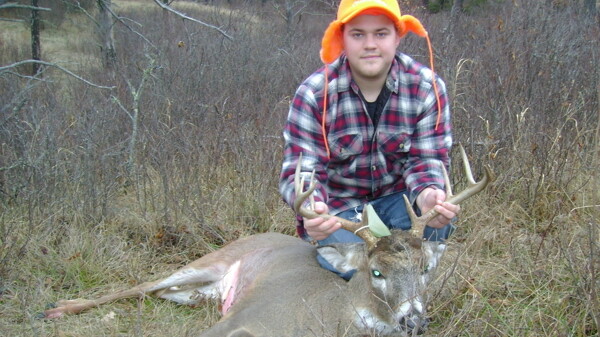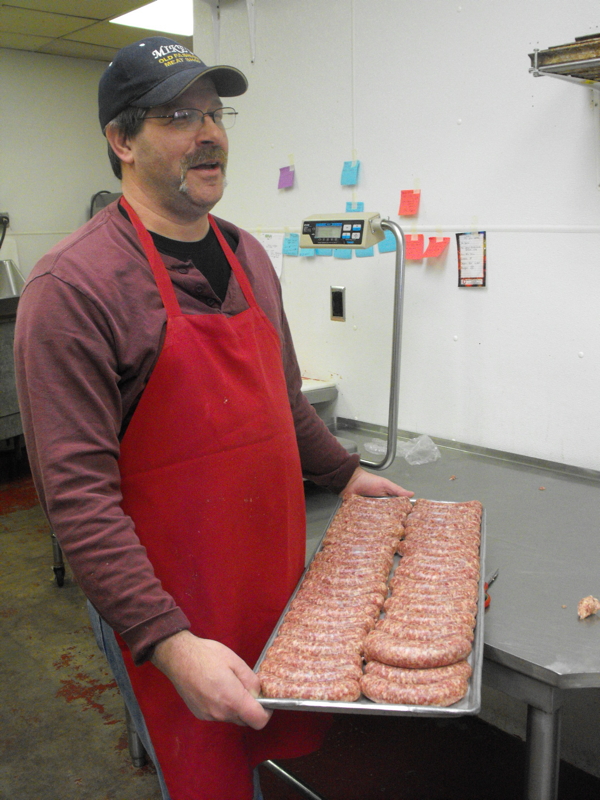Why Should Carnivores Stay Local? That’s All We Have.
Progressive plant-eating types may come off as a little high and mighty sometimes, but they do know a thing or two about sustainability.
Rob Hanson, photos by Rob Hanson |

It’s that buzzword you’ve seen pop up as an adjective for everything from campus buildings to farming to manufacturing – a buzzword that has almost single-handedly converted a generation of vegetarians. The word is also an Internet favorite that has left us chewing on the idea that our beloved chops, roasts, and ribs might not be the best for us or the world around us.
But hold, I say! Before you swear off the sausage and chuck the chicken, there’s a way you can have your steak and eat it too. The focus of this Volume One special section is not just meat, but by and large meat that is produced locally.
If you’re anything like me, the overuse of any buzzword tends to make it more offensive than the actual concept it represents. However, the “local” movement is truly a force that transcends trends and provides benefits to a community’s economy and the world environment that far exceed the often slightly higher price tag.
The core of the sustainability argument against eating meat lies within the agriculture system as a whole – not just how we produce meat, but also how we produce vegetables.
The fact is that the disproportionate amount of water and feed necessary to create one single pound of edible meat is unsustainable. (Reports vary widely, but the consensus is right around 20 lbs. of feed and 200 gallons of water to irrigate feed crops to produce a pound of beef, according to Stanford University researchers.) But it’s also unsustainable to eat pesticide-resistant, genetically modified corn that ensures the extinction of native plant and animal species. Turning prairie into grazing land definitely is a harmful practice, but so is clearing tropical rainforests for commodity crops such as coffee and tropical fruit.
Meat (and the gathering of it) is not for everyone, so if those of us who do eat it would take only what we need, we may find something more
closely resembling equilibrium.
Studies show the amount of methane, a greenhouse gas, produced by cattle lays a heavier carbon footprint on our environment than even the vast amounts of fossil fuel we burn for energy. But then again, the massive quantity of nitrogen fertilizer we have introduced to feed our soil-tiring monoculture crops has also found its way via our rivers to the Gulf of Mexico, where it leaves an equally ugly imprint on the Earth in the form of a dead zone where few marine species can survive and generations of fisherman are out of work.
To put it in fewer words, meat can be less sustainable to produce than other foods. Any food can be produced unsustainably if we try hard enough. But if we buy our meat from local producers who have sustainable practices in mind or collect it ourselves from the wild as the universe intended, many (if not all) of the aforementioned environmental horrors are reduced and we throw a few bucks to our neighbors instead of a corporation to boot.
Grass-fed lamb that comes from six-miles outside of town isn’t just easier on the environment than some growth-hormone injected sheep from Kansas, it also comes with the peace of mind that it wasn’t processed in a factory with thousands of other carcasses.
If one opts for a fresh fish fry over sushi, in theory a bucket of Half Moon bluegills can save the life of a threatened bluefin tuna. And I’ll be damned if another foodie tries to tell me his kale – which is trucked across an entire continent to the Great White North nine-months of the year – is somehow more sustainable than grilling up the buck I shot on the back 40.
And other than a small portion of the population, most people won’t need to be convinced: Demand for meat and other animal products continues to grow on the world market. In 2012 the US alone consumed approximately 52 billion pounds of meat, with an average of about 270 lbs. per person, according to a National Public Radio report.
Setting sustainability aside and putting personal health in the spotlight, whether the pursuit of meaty goodness comes from hunting, fishing, raising a few chickens in the backyard, or trading in the lawn mower for a beef cow, we can also rest assured when we eat local and organic that our meat isn’t pumped full of chemicals or hormones that may have unintended consequences in the long run.
Through many massive food recalls and investigative reports, most consumers are well aware of the cruelty and general profit-over-public health mentality of the modern food machine, and it has left many people looking for a better way. Far more than the hunt is about bloodlust and buying local and organic is about being trendy, the local movement is about sitting down to a pile of protein you know for a fact contains no pink slime, no BGH, BST, MSG, or BS in general. It’s about eating an animal that lived a full and natural life and was harvested in an ethical way, versus a sick critter bred to be so large it can’t walk or reproduce, only to be dispatched on a filthy killing floor among hundreds of others.
Moderation is key, though, to a mostly guilt-free meat experience. Participate in the “Meatless Monday” movement if it strikes your fancy. Using the numbers above, we can assume that an average person consumes roughly three-quarters of a pound of meat per day. If one goes even one day per week without meat, that amounts to 38 pounds of meat saved in a year. If we’re talking beef, that means conserving a total of 760 lbs. of grain and the 7,600 gallons of water necessary to irrigate it.
If anything is unsustainable, it’s advocating for the world’s 7 billion people to take up arms and put wild meat on the table for every meal. The same could be said if we buy from small local organic farms while consuming at the rate supported only by factory farms. It just doesn’t work. However, meat (and the gathering of it) is not for everyone, so if those of us who do eat it would take only what we need, we may find something more closely resembling equilibrium.
In his acclaimed book Noble Savages, anthropologist Napoleon Chagnon describes a unique verb used by the Yanamami tribe of central Venezuela and Brazil – “dehai” – which refers to nature’s gift of a savory bite of meat and vegetable at the same time.
I’m with those guys.
Because nothing soothes a lonely venison steak like a blanket of sautéed onions and mushrooms, and nothing lies next to a marinated grouse breast quite like asparagus.
DIY Butchering
Butcher Mike Maier of Mike’s Star Market
in Eau ClaireHunting, fishing and small scale farming can be a way to reconnect to the system that sustains us and possibly to that small section of hunter-gatherer genetic code buried long ago by the supermarket. However, whether you process it yourself, or take your wild meat to local butcher, there are of course some do’s and dont’s to keeping your organic fare safe and tasty. Butcher Mike Maier, of Mike’s Star Market, 2238 Heimstad Road, as well as some guidelines from the Environmental Protection Agency and Wisconsin Department of Natural Resources shed some light on the keys to being a DIY-butcher:
VENISON
If an animal is harvested at dark and because of extenuating circumstances must be recovered the next morning, be very wary – especially during warmer early season hunts. If upon field dressing the meat smells bad or has taken on a grayish or green hue, as much as you hate to do it, leave it for the coyotes. One of the most common mistakes Maier sees when hunters bring in game for processing is inadvertently tainting their meat by leaving organs during the field dressing process, particularly the windpipe and anus. Wash the meat with cold water as soon as possible. With the cavity open, what you see is almost exactly what’s going in your freezer. No one seasons a steak with grains of sand, blades of grass, or those ever-savory internal juices. Ice is your friend. While hanging venison for a few days can help tenderize the meat, keeping the carcass cool is essential. Packing the cavity with ice while the hide is still on the animal will help keep the meat at a desired temperature. If the outside temperature pushes 40 degrees and doesn’t cool below freezing at night, it’s a good idea to butcher your deer right away. After cutting your steaks and roasts, you may decide to take the remaining small bits or “grind” and make sausage or sticks, etc. During that process you will almost certainly have to visit your local butcher to purchase casings or seasoning. At Mike’s Meats a huge part of the business is helping home processors avoid mistakes, and Maier says the best thing you can do is ask if you have questions about the process.FISH
As with other meats, keeping your catch clean and cool is important to safe and delicious fish. However, the greater concern is fish containing mercury or PCBs through bioaccumulation. The principal works like this: Smaller species of fish such as bluegill or crappie eat mostly insects, which tend not to retain as much mercury or PCBs, and therefore don’t constantly accumulate the substances through their diet. However, bluegills living in contaminated water do retain a certain amount of the toxins. So larger fish such as pike or walleye – which eat those smaller fish by the dozen – do accumulate the contaminants in their diet at higher levels. For this reason, guidelines on the DNR website generally recommend only one meal of panfish per week for women of child-bearing age and children 15 and younger, and one meal of gamefish per month. Men older than 15 have a mostly unrestricted allowance of panfish, but still should only eat one meal of bass, pike, or walleye per month. It is not recommended to eat the top predator in local water, the muskellunge. These general guidelines can be superseded by warnings on specific bodies of water, locally including the Chippewa River downstream of the Holcombe Dam and Horseshoe Lake, Round Lake, and Sand Lake in Chippewa County. For a map of warnings related to fish consumption, visit dnr.wi.gov/topic/Fishing/consumption.





















